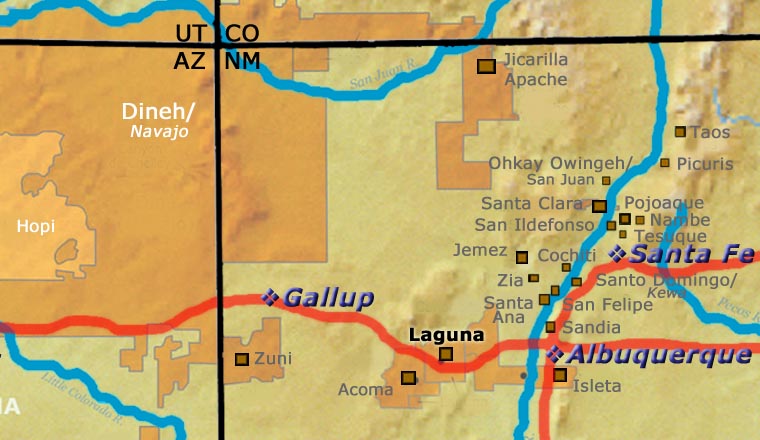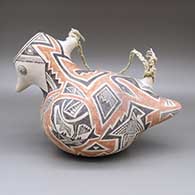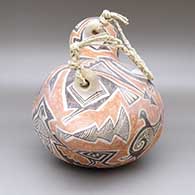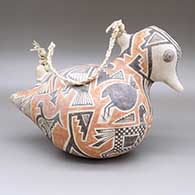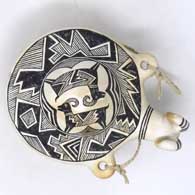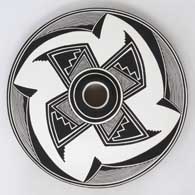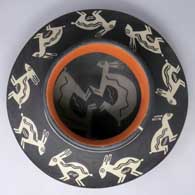
Michael Kanteena
Laguna
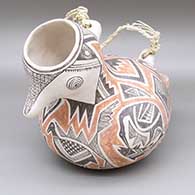
Michael Kanteena was born in Laguna Pueblo in 1959. He always had an interest in pottery, fueled by the pottery shards he found all over the Laguna landscape. Michael graduated from Eastern New Mexico University with a BA in Fine Arts in 1981. Then he returned to Laguna and began recreating historic and pre-historic styles of pottery and decorating them with design motifs from the pre-historic Mimbres culture and other ancient peoples. Many of his creations are almost indistinguishable from pottery made 500 or more years ago.
He says his inspiration comes from Mesa Verde, Chaco, Mimbres and other Ancestral Puebloan pottery. He merges the influences of past and present into his contemporary creations, thereby making his work very distinct from other pueblo potters. Michael also creates distinctive pottery inspired by katsina dolls and masks.
Michael's work is shown at the Maxwell Museum in Albuquerque and the Wheelwright Museum in Santa Fe. He has participated in shows like the Santa Fe Indian Market and the Heard Museum Guild Indian Fair and Market, earning ribbons in almost every show. The Heard has even honored him with the Wingspread Collector's Guide Award of Excellence and the prestigious Judge's Choice ribbon.
These days, after his studies of multiple ancient cultures, Michael may create a contemporary effigy based on a Toltec theme and decorate it with Chacoan designs, or a contemporary canteen with a bighorn ram effigy spout and decorate the whole with Mimbres and Aztec designs. In keeping with ancient Laguna custom, he always creates in what may be called a "Cibola-Revival" black-on-white style. Cibola black-on-white was one of the very earliest styles of pottery made in the Southwest.
100 West San Francisco Street, Santa Fe, New Mexico 87501
(505) 986-1234 - www.andreafisherpottery.com - All Rights Reserved

Laguna Pueblo
After the Pueblo Revolt of 1680, many Puebloans were fearful of Spanish reprisals. Spanish militias returned in 1681 and again in 1689. That first return brought them as far north as Isleta and that pueblo was attacked, looted and burned. The second return saw troops marching up to Santa Ana and San Felipe, attacking, looting and burning both. In those years, when the Puebloans became aware of approaching Spanish forces they mostly scattered into the mountains and the Spanish found empty pueblos, easy to loot and easy to burn. When Don Diego de Vargas marched north in 1692, he was intent on reconquering Nuevo Mexico and re-establishing a long-term Spanish presence there. As the conquistadors who accompanied him were on a "do-or-die" mission, the reconquest took on a tenor quite different from the previous missions...
At first de Vargas followed a path of reconciliation with the pueblos but that was soon replaced with an iron fist that brought on a second revolt in 1696. The pueblos didn't fare so well the second time around and a large number of Pueblo warriors were executed while their wives and children were forced into slavery. When word of de Vargas actions got back to the King of Spain, he ordered de Vargas banned from the New World. However, most of the damage was already done.
Many modern historians say Laguna Pueblo was established between 1697 and 1699 by refugees seeking to avoid fighting with the Spanish. Many of those refugees had left the first pueblos approached by the Spanish in 1692. They had first scattered to more remote places like Acoma, Zuni and Hopi, or to more Spanish-friendly Isleta. However, the pressure of those refugees strained the resources of the other pueblos and quickly forced the refugees to consider starting a new existence in a newly-formed pueblo. The area of Laguna had been settled several hundred years previously by ancestors of today's tribe but had been abandoned during the periods of great drought that had brought the Ancestral Puebloans (Anasazi) down from the Four Corners area to the areas where we now find the Rio Grande Pueblos. Some of the land under Laguna control has also been found to contain archaeological resources dating as far back as 3,000 BC. The prehistoric village of Pottery Mound is located just east of today's Laguna Pueblo boundary. Pottery Mound was abandoned long before the Spanish first arrived but archaeologists have followed the tracks left by Pottery Mound styles, shapes and designs to settlements in the Hopi mesas and the Four Corners area.
Over time, several villages were established in the area around Old Laguna and when the Lagunas were granted their own reservation, they were given about 500,000 acres of land, making Laguna one of the largest of all pueblos in terms of land. However, only about half the enrolled members of the tribe live at Laguna as many have been drawn to nearby Albuquerque in search of work.
Laguna and Acoma share the same language (Western Keresan), similar pottery styles and similar religious beliefs. However, pottery making almost died out at Laguna after the railroads arrived in New Mexico in 1880 and laid a primary east-west trackbed directly in front of the Laguna main pueblo. During that time period many Lagunas went to work on railroad construction crews and many of the traditional Laguna arts and crafts died out. Potterymaking never completely stopped at Laguna but by 1960 it was almost gone. Then in 1973 and again in 1974 Nancy Winslow taught two four-month arts and crafts classes at the pueblo. Among the 22 pueblo members in the first class were Evelyn Cheromiah and her daughters. Rick Dillingham quoted Evelyn Cheromiah as saying that after "looking at my mother's pottery-making tools, I got the urge of going back to making pottery." That was the beginning of today's renaissance in Laguna pottery.
Because of their geographic proximity, Laguna and Acoma clays are very similar. In some instances, it's very hard to determine if a particular pot is from Acoma or from Laguna. Laguna potters are more likely to temper their white clay with sand than with ground up pot shards like the Acomas do. Laguna geometric designs also tend to be bolder than Acoma designs while Laguna potters use Mimbres designs much more sparingly than do Acoma potters.
100 West San Francisco Street, Santa Fe, New Mexico 87501
(505) 986-1234 - www.andreafisherpottery.com - All Rights Reserved

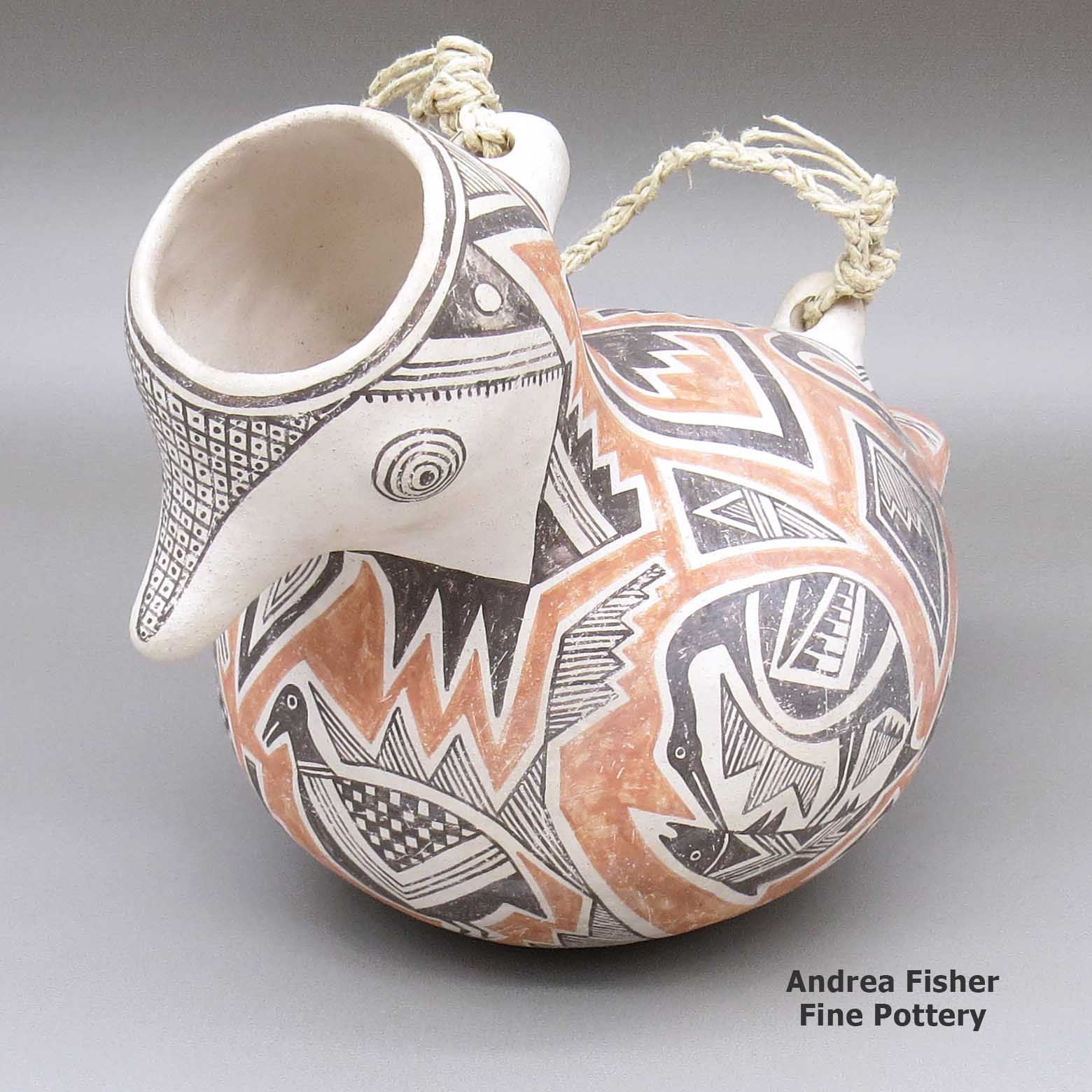
Michael Kanteena, Laguna, PolychromebirdjarwithabraidedropehandleandaMimbrescloudeater,bird,andgeometricdesign
Laguna
$ 2250
zzla3b519
Polychrome bird jar with a braided rope handle and a Mimbres cloudeater, bird, and geometric design
12 in L by 7.5 in W by 8.5 in H
Condition: Very good, intentional weathering
Signature: Kanteena Laguna NM
100 West San Francisco Street, Santa Fe, New Mexico 87501
(505) 986-1234 - www.andreafisherpottery.com - All Rights Reserved

Mimbres Pottery
Mimbres Mogollon Culture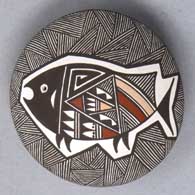
Rebecca Lucario
Acoma

Verda Toledo
Jemez
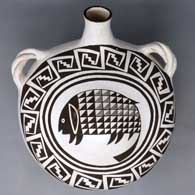
Marie Z. Chino
Acoma
The Mimbres Mogollon culture was named for the Mimbres River in the Gila Mountains. They lived in the area from about 850 CE to about 1150 CE. Substantial depopulation of the area occurred but there were many small surviving populations. Over time, these melted into the surrounding cultures with many families moving north to Acoma, Zuni and Hopi while others moved south to Casas Grande and Paquimé.
The time period from about 850 CE to about 1000 CE is classed the Late Basketmaker III period. The time period was characterized by the evolution of square and rectangular pithouses with plastered floors and walls. Ceremonial structures were generally dug deep into the ground. Local forms of pottery have been classified as early Mimbres black-on-white (formerly Boldface Black-on-White), textured plainware and red-on-cream.
The Classic Mimbres phase (1000 CE to 1150 CE) was marked with the construction of larger buildings in clusters of communities around open plazas. Some constructions had up to 150 rooms. Most groupings of rooms included a ceremonial room, although smaller square or rectangular underground kivas with roof openings were also being used. Classic Mimbres settlements were located in areas with well-watered floodplains available, suitable for the growing of maize, squash and beans. The villages were limited in size by the ability of the local area to grow enough food to support the village.
Pottery produced in the Mimbres region is distinct in style and decoration. Early Mimbres black-on-white pottery was primarily decorated with bold geometric designs, although some early pieces show human and animal figures. Over time the rendering of figurative and geometric designs grew more refined, sophisticated and diverse, suggesting community prosperity and a rich ceremonial life. Classic Mimbres black-on-white pottery is also characterized by bold geometric shapes but done with refined brushwork and very fine linework. Designs may include figures of one or multiple humans, animals or other shapes, bounded by either geometric decorations or by simple rim bands. A common figure on a Mimbres pot is the turkey, another is the thunderbird. There are also a lot of different fish depicted, some are species found in the Gulf of California.
A lot of Mimbres bowls (with kill holes) have been found in archaeological excavations but most Mimbres pottery shows evidence it was actually used in day-to-day life and wasn't produced just for burial purposes.
There's a lot of speculation as to what happened to the Mimbres people as their countryside was rapidly depopulated after about 1150 CE. The people of Isleta, Acoma and Laguna find ancient Mimbres pot shards on their pueblo lands, indicating that pottery designs from the Mimbres River area migrated north. There are similar designs found on pot shards littering the ground around Casas Grandes and Paquime near Mata Ortiz and Nuevo Casas Grandes in northern Mexico. Other than where they went, the only reasons offered for why they left involve at least small scale climate change. The usual comment is "drought" but drought could have been brought on by the eruption of a volcano on the other side of the planet, or a small change in the El Nino-La Nina schedule. Whatever it was that started the outflow of people, it began in the Mimbres River area and spread outward from there. Excavations in the Eastern Mimbres region (nearer to Truth or Consequences, New Mexico) have shown that the people adapted to new circumstances and that adaptation itself moved them closer into alignment with surrounding tribes and cultures. Eventually they just kind of merged into the background, although the groups that moved south and built up Paquime and Casas Grandes seem to have lost a war and survivors migrated to the west, to a land a bit more hospitable for them.
100 West San Francisco Street, Santa Fe, New Mexico 87501
(505) 986-1234 - www.andreafisherpottery.com - All Rights Reserved
